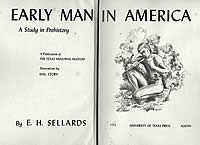
Kincaid Shelter was mentioned
only briefly in E. H. Sellards' 1952 book, Early
Man in North America. The site is of interest,
he noted, "as one of the southernmost localities
at which typical Folsom points are known to occur." Sellards, who directed investigations at the site
in 1948, made no mention of the stone pavement.
The Clovis artifacts from the site had not yet
been recognized.
Click images to enlarge
|

Paleoindian specialist Michael
Collins reviews photos of artifacts from the Late
Pleistocene Zone 4 deposits at Kincaid. His reanalysis
of these early artifacts and other data finally
answered the question, "Who built the stone pavement
at Kincaid?" Photo by Susan Dial.
|
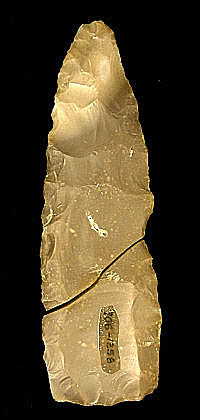
The re-joined Clovis biface,
or preform. Before they were recognized, the sections
had been separated in two different institutions
since the 1950s: the pointed distal section on
display at the Texas Memorial Museum, and the
base at TARL. The broad flake scars extending
nearly across the face of the biface are characteristic
of Clovis technology. The object was broken during
manufacturing, according to Collins, after the
first flute had been removed. Photo by Aaron Norment.
Click to enlarge and see drawing.
|
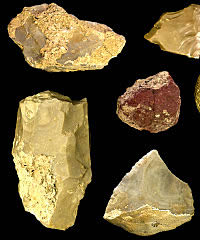
Artifacts from Zone 4. Photos
by Aaron Norment. Click to see full image.
|
|
Coming Full Circle
There are aspects of serendipity and no
small amount of irony in the Kincaid discoveries, beginning
with Gene Mear's find of a Folsom point in the backdirt
piles left by treasure hunters. Had it not been for
the destructive activity of the treasure seekers, Mear
would not have discovered the Paleoindian points, scientific
investigations might never have taken place, and the
ancient stone pavement at Kincaid Shelter might never
have been uncovered.
The serendipity was to continue and come
full circle in subsequent years.
In the early 1950s, findings from Kincaid
Shelter were showcased in what became a longstanding
exhibit at the Texas Memorial Museum in Austin. Along
with a selection of artifacts, a section of the ancient
stone pavement was recreated and displayed. The text
for the exhibit explained that, while evidence of the
Folsom culture was found at the site, it was not known
what ancient civilization had constructed the
stone pavement—the thinking of the time perhaps
being that brutish hunter-gatherers would have had neither
the organizational skills nor the inclination to put
forth the effort required.
UT-Austin archeologist Michael Collins
recalls visiting the Kincaid exhibit as a young boy,
pressing his face against the glass display window,
and wondering about the ancient people who had created
the stone floor in the shelter. The question was to
nag him over the years as he went off to college and
began studying archeology and prehistoric cultures.
In 1988, armed with a Ph.D and some 20
years experience in the field, Collins obtained permission
to examine the Kincaid artifacts, still on display at
the museum. One specimen caught his attention—the
tip of a broken biface that had been recovered from
Zone 4. Looking at the flake scars on the fragment,
Collins recalls, "I knew that was Clovis technology."
At the Texas Archeological Research Laboratory, where
the bulk of the Kincaid collection had been curated,
Collins examined the rest of the collection. There,
among a bag of triangular bifaces classified as "Kinney"
type specimens, Collins spotted a fragment with a fluted
base and unusual flaking pattern.
He held up the basal fragment next to
the photo of the tip from the museum display. The break
on the object in his hand was a mirror image of the
one in the museum display. After 40 years of being housed
in two different facilities, the two pieces were joined
together. It was, as Collins had suspected, a Clovis
preform, broken by an ancient knapper attempting to
make a spear point some 13,000 years ago.
The Case for Clovis
For Collins, the mystery of who had built
the stone floor at Kincaid had been answered. In subsequent
years, as he begun delving into early Paleoinidan tool-making
technology, Collins identified other Clovis artifacts
from the Kincaid collection—an expended conical
blade core, more fluted bifaces and preforms, and other
distinctive knapping debris.
Collins also interviewed longtime friend
and mentor Glen Evans, who had excavated the site in
1948, "picking his brain" for recollections
about other artifacts, such as long thin, Clovis blades—another
distinctive Clovis signature—which might not have
been collected at the time. (During the 1940s and 1950s,
it was not standard procedure to collect all lithic
materials found during archeological excavations.) Evans
was certain there had been no thin blades in Zone 4.
Gene Mear, who had retired after a successful
career in petroleum geology, later joined Collins in
examining the site records and re-inventorying the Kincaid
collection, measuring and recording attributes on the
chipped stone tools.
Having sifted through the collection and
the records for any other possible evidence pertaining
to Zone 4, Collins and his colleagues summed up the
newly identified Clovis lithic materials from Kincaid
in a short article in Current Research in
the Pleistocene:
From on and just above the pavement
were recovered flakes, a blade core, two bifaces broken
in early stages of reduction, a preform broken during
percussion thinning after successful removal of one
flute, and preparation of the platform for the second
flute, a basal fragment of a lanceolate obsidian point,
and three large retouched flakes. A reworked Clovis
point and several non-diagnostic pieces with adhering
travertine recovered from the looter's backdirt almost
certainly belong with the Zone 4 specimens. The chert-working
evidence suggests a Clovis habitation.
|
|
In this section:
|
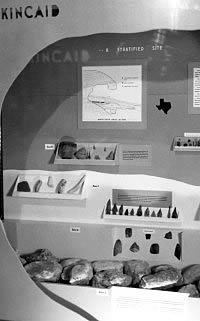
The Kincaid Shelter exhibit
at the Texas Memorial Museum in Austin from the
1950s to 1990s, recreated a small section of the
stone pavement and posed the question, "What ancient
civilization built this?" For archeologist Mike
Collins, who visited the museum as a boy, the
question was to haunt him for decades. Photo courtesy
Texas Memorial Museum, University of Texas at
Austin.
|
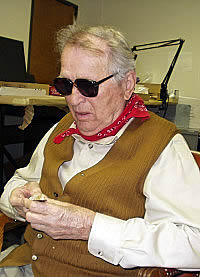
Geologist Glen Evans examines
a thin blade from another Clovis site on a recent
visit with Mike Collins at TARL. No blades were
collected from the Kincaid site, and Evans, today
relying heavily on a sense of touch to compensate
for encroaching macular degeneration, is quite
certain there were none in the Zone 4 deposits.
A longtime friend and mentor of Collins, Evans
has talked about the site with his younger colleague
on numerous occasions and is anxious to bring
the site to the attention of the public. Photo
by Susan Dial.
|
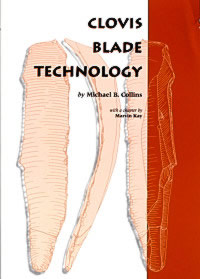
Collins published his 1999
study on Clovis Blade Technology based on tools
from several sites, including Kincaid (University
Texas Press). |
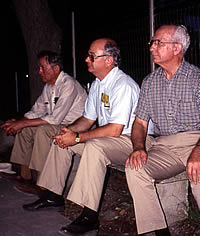
Kincaid researchers were on
hand to give a talk about the shelter during a
nighttime meeting of the Texas Archological Society
field school in Utopia. Glen Evans is shown at
left, and Gene Mear, right. Archeologist Tom Hester,
shown center, directed the Utopia field school,
and commissioned a trace element study on the
Paleoindian obsidian artifact found at the Kincaid
site.
|
|
|

This series of Clovis bifacial preforms
illustrates knapping gone wrong at different stages, from
early stage reduction failures, left and center, to a first
fluting attempt, right, that severed the preform in half.
Drawings by Pam Headrick. Photos by Aaron Norment.
|
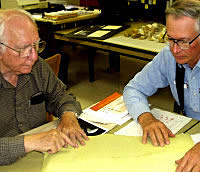
Gene Mear, left, re-inventoried
and measured many of the chipped stone tools from
Kincaid. Here he reviews a site map with Mike
Collins. Both researchers hope to fully analyze
and report their findings in the future. Photo
by Susan Dial.
|

Bone sampled in early dating
attempt. In 1954, samples of bone, charcoal, snail,
and and other materials from the site were submitted
for radiocarbon dating, a pioneering new technique
that Willard Libby was struggling to perfect at
that time. None of the results on the Kincaid
materials, however, proved satisfactory. This
bone sample, like the others, was wrapped in foil
as it was uncovered at the site as a protection
from contamination.
|
|
No recognizable Folsom-period debitage or
manufacturing failures were identified at Kincaid.
As opposed to evidence of habitation, the five
virtually unbroken Folsom points from the site
are more characteristic of a kill sites.
|
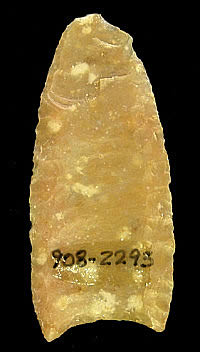
One of the five Folsom points
from Kincaid. Notably, all of the points are virtually
complete, although two, including this specimen,
have apparent impact fractures (note the damaged
tip section).
|
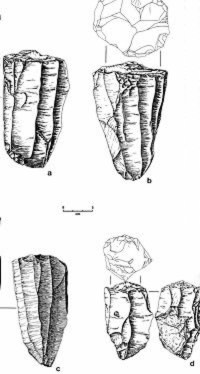
Clovis blade cores from several
sites. The small, expended Kincaid specimen (d),
lower right, is not easily recognizable as such,
and is dwarfed by the more classic examples (a-c)
from other sites. Drawing by Pam Headrick featured
in Clovis Blade Technology by Michael Collins
(1999, UT Press, Austin). Click to enlarge.
|
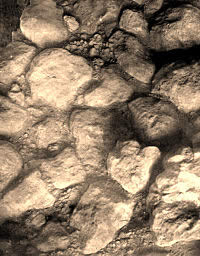
The stone pavement at Kincaid,
oldest known structural feature in North America.
Photo by Glen Evans. Click to enlarge.
|
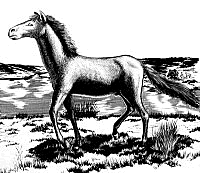
American horse, Equus. A bone
from this extinct species was found on top of
the stone pavement, helping to establish the feature
as Late Pleistocene in age. Drawing by Hal Story.
|
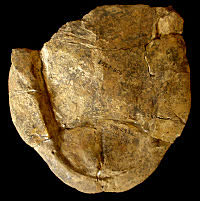
The plastron, or bottom plate
of a turtle (Terapene carolinus), found in Zone
4. Although bones of megafauna, such as mammoth,
bison, and horse, were found in Zone 4, the identification
of smaller species, such as turtle and alligator,
supports new viewpoints about a broad-spectrum
Clovis diet. Turtle, in particular, has been found
in numerous Clovis sites. Photo by Susan Dial.
Click to enlarge.
|
|
Dating the Deposit
The handful of artifacts from Zone 4 and
the reworked projectile point from disturbed fill was
not sufficient evidence at the time to totally convince
other archeologists that the deposit could be attributed
to Clovis peoples. But there was no other evidence,
such as a radiocarbon date for the deposit, to strengthen
the case.
Earlier attempts at dating Kincaid samples
had proved unsuccessful. In 1953, upon learning of the
pioneering new radiocarbon dating techniques being tested
by Willard Libby, Evans had begun a persistent letter-writing
campaign to include some of the Kincaid samples in the
study. Because some of the samples were from contexts
associated with diagnostic projectile points or Late
Pleistocene fauna—and thus placed in a relative
chronological framework—Libby finally accepted
several samples as good test cases for his new technique.
In each case, however, the results were unsatisfactory—either
far too young or too old based on the evidence at hand.
Several of the samples used were snail shells, bone,
and other materials which are now known to require special
calibrations and processing methods. (Over the ensuing
years, Libby improved his technique and was awarded
the 1960 Nobel prize for his work.)
In 1990, Collins tried again, submitting
two painstakingly collected samples of charcoal to the
Lawrence Livermore Laboratory at the University of California-Berkeley
for accelerator mass spectrometry (AMS) dating. A major
advance over standard radiocarbon dating, this revolutionary
new technique can evaluate the age of even minute samples
of charcoal. The two Kincaid charcoal samples, Collins
recalls, looked like "flecks from a pepper shaker."
Using tweezers, he extracted the first speck from the
surface of a lump of travertine that had been collected
from Zone 4. The resulting radiocarbon age estimate
of that sample proved to be unsatisfactory, perhaps
contaminated during initial collection or storage.
To produce a second sample, Collins crushed
the travertine lump and removed a charcoal fleck from
the interior. This sample brought results—an AMS
radiocarbon age estimate of 9910 +/-250 years before
present, or, in calendar years, roughly 12,000 years
old. What this established, in effect, was an end date
for the accumulation of Zone 4 deposits.
Haunting Questions
Did Folsom people live in Kincaid Shelter?
Five Folsom points were recovered from
disturbed contexts at Kincaid, and these points are
interesting in several regards. They are all essentially
complete, except for minor impact fractures on three.
But it appears that they are the only evidence
of Folsom people at the site. According to Collins,
there is no other artifact—such as channel flakes,
distinctive fluted preforms, or fragments of Folsom
points— that can be attributed to a Folsom assemblage
from the site. No recognizable chipping debris or Folsom
manufacturing failures (broken tools) were identified.
As opposed to evidence of habitation, the five virtually
unbroken points are more characteristic of a kill sites.
Collins notes that since all five points
came from the backdirt of the large pit, they evidently
laid in close proximity near the back of the shelter
at one time. The points did not have any travertine
coating and, therefore, seem to post-date Zone 4. The
articulated leg bones of a single bison lay on the surface
of a travertine deposit at the contact between Zone
4 and Zone 5, adjacent to the largest pit.
A very intriguing and plausible explanation
of these circumstances has been proposed by Dr. Dee
Ann Story, who as a student dug at Kincaid in 1953.
In her hypothesis, Folsom hunters may have wounded a
bison with multiple darts. The bison apparently escaped
and perhaps sought refuge in the shelter. It died of
its wounds on the floor of the shelter (then the upper
surface of Zone 4) at a spot later penetrated by the
treasure-hunters. Their digging dislodged the majority
of the bison skeleton and all of the points, leaving
only the articulated limb bones found adjacent to the
pit at the contact between Zones 4 and 5.
Unfortunately, the nature of the Folsom
presence at Kincaid will remain a matter of speculation.
Because the deposit containing Folsom materials was
evidently almost totally disrupted by a treasure-hunters'
pit, it must not have covered a large area to begin
with.
What was the size and
lifestyle of the Clovis group?
Because of a variety of disturbances to
the deposits and because of incomplete recovery of artifacts
by investigators, our picture of the ancient groups
who stayed at Kincaid will remain blurred. Based on
the size of the stone pavement section uncovered during
controlled excavations— roughly 10 square meters—it
is clear that ancient builders expended substantial
effort in its making, But there is no way of knowing
what its original, full dimensions might have been.
Lacking that evidence, speculation about
group size is rather meaningless. However, the shelter
is large—roughly 35 by 32 feet, or 10 by 11 meters.
As Collins has noted, even though the known paved area
is comparatively small, it required considerable effort
to construct. These facts, he adds, suggest a group
of sufficient size to have required the entire floor
space of the shelter. And they would have intended to
stay sufficiently long to warrant the effort to build
the pavement.
Based on the artifact evidence, it seems
clear that the shelter was used as a habitation and
as a Clovis "workshop" for making chipped
stone tools. We can imagine a scene13,000 years ago
when a Clovis craftsman, perhaps wielding a heavy antler
baton, struck blades off a small chert core. Another
worker may have refreshed his hunting gear by pulling
a broken black-glass projectile point from a dart shaft
and replacing it with a new tip.
With the exception of the obsidian point,
the tool stone chosen, almost uniformly, was local Edwards
chert, based on appearance and on a cursory scan with
ultra violet light by Collins. The resharpened Clovis
point found at Kincaid is of interest in this regard.
As Collins notes in his study, Clovis Blade Technology
(1999, University of Texas Press), the fact that the
discarded point at Kincaid was made of the same local
material as the knapping debris indicates a return to
the same chert source within the use-life-span of the
points.
The Kincaid Legacy
With the analysis and identification of
the Clovis artifacts, Kincaid Shelter took its place
in a relatively small universe of early Paleoindian
sites. Several aspects distinguish it from others, while
other Kincaid evidence provides support for an ongoing
shift in our thinking about these early groups.
- The stone pavement is the oldest
reported construction in North America, some 13,000
years old. At other sites, such as Hell Gap and
Agate Basin, investigators have found the remains
of possible tent stakes made of bone or tusk, but
these sites are younger than Kincaid by 1,000 to 1,500
years. At the Vail site in Maine, there is an arrangement
of huge boulders, cobbles, and chipped stone tools
on a stream-side gravel bar. Although their arrangement
is circular, the boulders are too massive to have
been moved by humans. It is possible they were used
as supports for some sort of structure.
There is also a suspected Clovis-age structural feature—a
rectangular gravel pavement—that was uncovered
at the Gault site north of Austin, but findings from
this major Clovis occupation site are still being
analyzed by Collins, the lead investigator, and his
team.
According to Collins, Kincaid is the only site with
indisputable evidence of Clovis-period construction,
and "there is the bone of an extinct horse lying
right on top of the pavement." Further, because
the site was excavated by geologists employing stratigraphic
principles, there is very sound stratigraphic context
for the pavement. Their geologic observations on the
type and arrangement of the limestone cobbles used
for paving stones (Edwards vs. Anacacho formation)
established further that it was not created by natural
forces, such as spalling.
- Kincaid is one of the first sites
known with an unequivocal Clovis component overlain
by Folsom. These are rare—only three or four
sites are presently known, the most important of these
being the Blackwater Draw site in New Mexico.
- Kincaid was the first site to produce
a Clovis blade core from a Clovis component and with
other Clovis materials.
- The obsidian projectile point base
found in Zone 4 is one of the southernmost obsidian
Paleoindian artifacts from a known stratigraphic context.
This is one item from Zone 4 that cannot be attributed
confidently to a Clovis assemblage, according to Collins.
It is of a size, thickness, and general outline comparable
to Clovis, and it does have basal thinning flakes
on one face. As Dr. Thomas R. Hester noted in his
trace element study, most of the obsidian Paleoindian
points found in Texas and New Mexico are Clovis. Obsidian
is a black, volcanic glass of unusual flaking properties.
The beautiful stone could only have been acquired
through trade or a long journey.
- Animal bones found in the Clovis
deposits (Zone 4) hint at a broad-spectrum diet not
solely based on big game. Along with bones of
horse, camel, bison, and mammoth, investigators also
found turtle, racoon, and alligator.
At other Clovis sites such as Gault, turtle and small
mammals have been identified as well. Turtle, in particular,
is gaining attention as the most common type of reptile
found in early sites in North America. These findings
are challenging the long-held notion of Clovis people
as chiefly mammoth hunters.
- The chert source materials used
by early Kincaid knappers (as well as the makers of
at least four of the five Folsom points) appear to
be local, indicating an intimate knowledge of the
landscape and environs. As with the faunal evidence,
this aspect also implies a less mobile lifeway than
previously assumed. This predominate use of local
materials has been seen at other Clovis sites, as
well.
- Kincaid was one of the sites to
provide samples for Willard Libby to use in his new
(at the time) radiocarbon dating experiments, although
the results were unsuccessful. Fortunately, a
tiny sample of charcoal from a chunk of travertine
later was successfully dated using accelerator mass
spectrometry. This sample helped establish an end-date
for the Zone 4 deposits at about 10,000 radiocarbon
years B.P. (or 12,000 years ago in calendar years).
The Loss of History
|
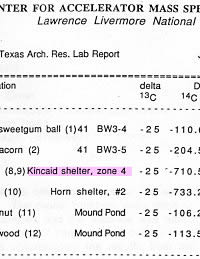
Lab results from dating a tiny
fleck of charcoal from Kincaid, using a revolutionary
new technique, established the travertine deposit
at 9910 radiocarbon years before present, or,
in calibrated calendar years, nearly 12,000 years
old. TARL Records. Click to enlarge.
|
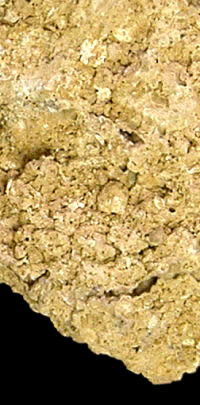
A lump of travertine from Kincaid
was crushed to produce an uncontaminated sample
of charcoal, no larger than a fleck of pepper,
for AMS radiocarbon dating. The results indicated
it was roughly 12,000 years old.
|

Field school student Dee Ann
Suhm gets a close-up view of the articulated bison
limbs found just above Zone 4 at the rear of the
shelter. Her theory is that a bison, wounded by
Folsom hunters, died in the shelter, thus accounting
for the five complete Folsom points found there.
The bones are the only evidence of a Folsom-age
deposit to survive the destruction of the treasure
hunters. Suhm, who later married illustrator Hal
Story, went on to earn a Ph.D in archeology, become
a professor of anthropology at UT-Austin and,
later, director of TARL.
|
|
We can imagine a scene in the shelter 13,000
years ago when a Clovis craftsman, perhaps wielding
a heavy antler baton, struck blades off a small
chert core. Another worker may have refreshed
his hunting gear by pulling a broken black-glass
projectile point from a dart shaft and replacing
it with a newly made tip.
|
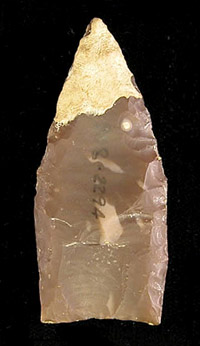
This heavily resharpened Clovis
point is made of local chert, as were most of
the other tools and knapping debris left by Clovis
workers at Kincaid. Click to enlarge and see drawing.
|
|
Kincaid is the only site with indisputable
evidence of Clovis-period construction, and there
is the bone of an extinct horse lying right on
top of the pavement.
-Mike Collins
|

Toolmaking debris from Zone
4. Kincaid was the first site to produce a Clovis
blade core (left) with other Clovis toolmaking
debris.
|
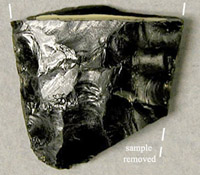
The obsidian base found in
Zone 4 near the articulated bison leg bones. The
point, untyped as yet but with Clovis affinities,
is unusual in several aspects. The obsidian material,
a black volcanic glass, has been traced to a source
near Querétaro, Mexico, some 600 miles
to the southwest.
|

Drawing of Kincaid Shelter
by Hal Story.
|
|
|
|
Four of the hundreds of artifacts dug out
of their original contexts at Kincaid Shelter by treasure
hunters. With the loss of context, artifacts lose their identity,
so to speak. Time frames are difficult to establish, except
through cross-dating with other sites, and no meaningful statements
can be made about the cultures who created them.
|
Michael Collins on reconnaissance at
Kincaid Shelter in 1988. The Paleoindian specialist, now
deeply immersed in writing up findings from the Gault site
in Bell County, Texas, still hopes to complete his analysis
of the Kincaid findings. He notes that, although all cultural
deposits were removed from the shelter, the artifact collections
and records are curated for posterity at the Texas Archeological
Research Laboratory at UT-Austin, ready for future analysts
to study and interpret using latest techniques and perspectives.
Photo by Thomas Hester. TARL archives.
Looking at the Kincaid collection today, it
is tragic to see that some of the most intriguing and potentially
informative specimens are labeled with the lot number "908-2"
and other numbers which signify, "provenience unknown."
What this has meant for researchers is that the items left
by prehistoric peoples camped in the shelter perhaps 12,000
years ago were unearthed and mixed together with those left
by shelter dwellers perhaps 8,000 or 5,000 or even 500 years
ago. For the most part, any meaningful connections among cultural
remains of the same time period have been lost.
While mixed deposits in archeological sites
are common, natural disturbances such as erosion or rodent
burrowing often are found to have been the cause. Prehistoric
people also disturbed earlier evidence simply by camping on
top of it, by recycling tools or stones from earlier hearths,
and by digging pits into earlier deposits. What archeologists
hope to prevent through continued education efforts is the
knowing destruction of historic sites by individuals who want
to collect a few more projectile points which, when separated
from their context, offer little insight into the people and
cultures who made them.
|
|